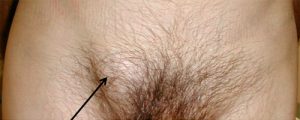An inguinal hernia is the most common type of hernia, typically seen in men.
The first warning sign is often some discomfort in the groin that is aggravated by prolonged standing. The aching sensation often relieved by rest. Some men with small inguinal hernias experience pain in the groin if driving for prolonged periods of time.

The inguinal hernia can appear as a swelling or lump in your groin, and this can stretch down towards the scrotum. The lump often appears when lifting something and disappears when you lie down.
About a quarter of men will develop hernias in both groins (bilateral inguinal hernias). A proportion of hernias will recur after previous surgery. These are called recurrent hernias. When patients have bilateral hernias or recurrent hernias the specialist will normally suggest that a laparoscopic (keyhole) repair is the best option.
If an open inguinal hernia repair is suggested, this may be performed under general anaesthetic (with you asleep) or under local anaesthetic (with you awake). A cut is made in the groin near the bulge, and the weakness in the muscle identified. Any hole is closed with stitches and often strengthened with a mesh. This gauze mesh, which is like a child’s fishing net, stays in the body and encourages scar tissue to form. This scar tissue ensures the hernia repair stays strong. Dissolving stitched are usually used for the skin.
